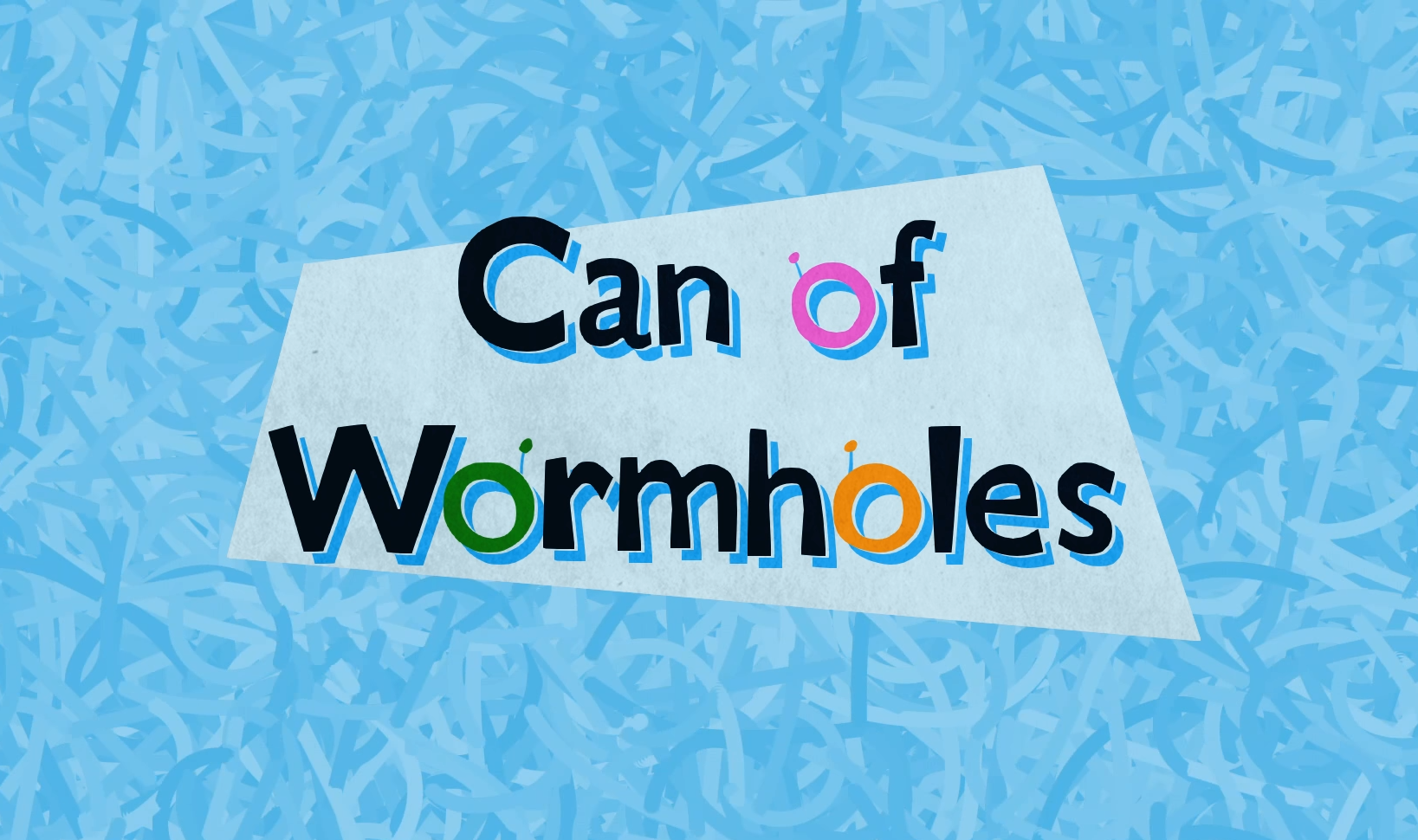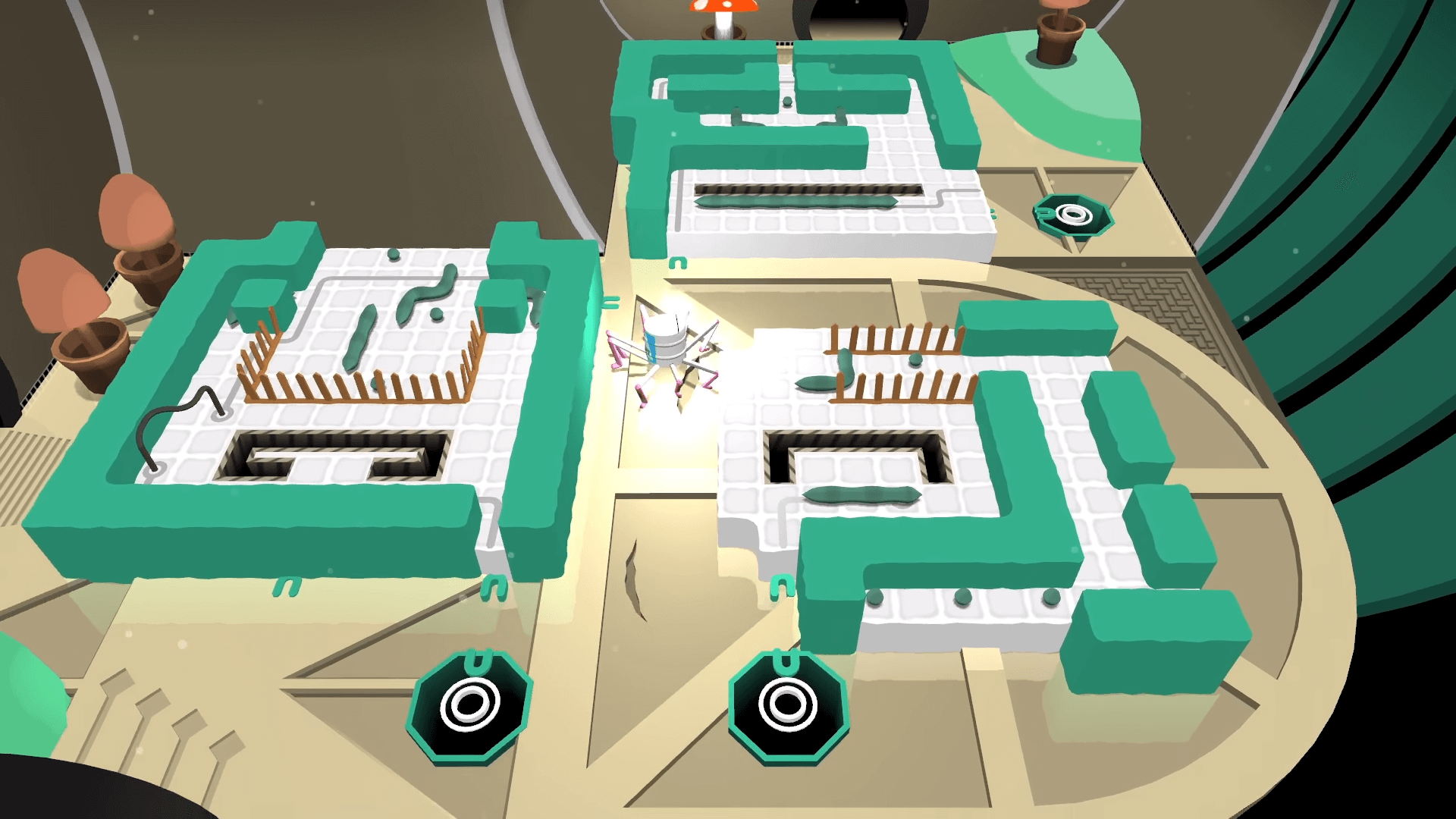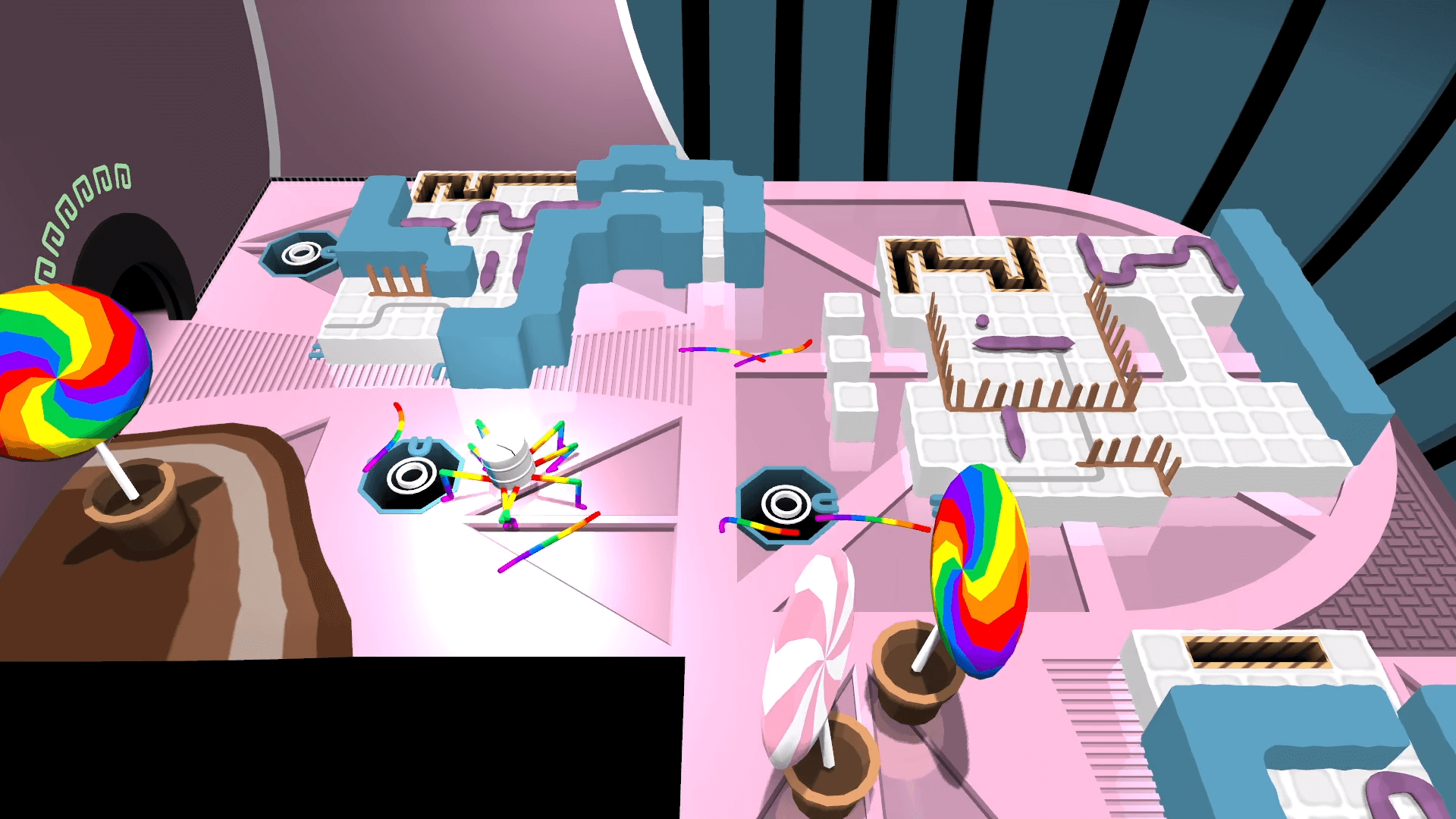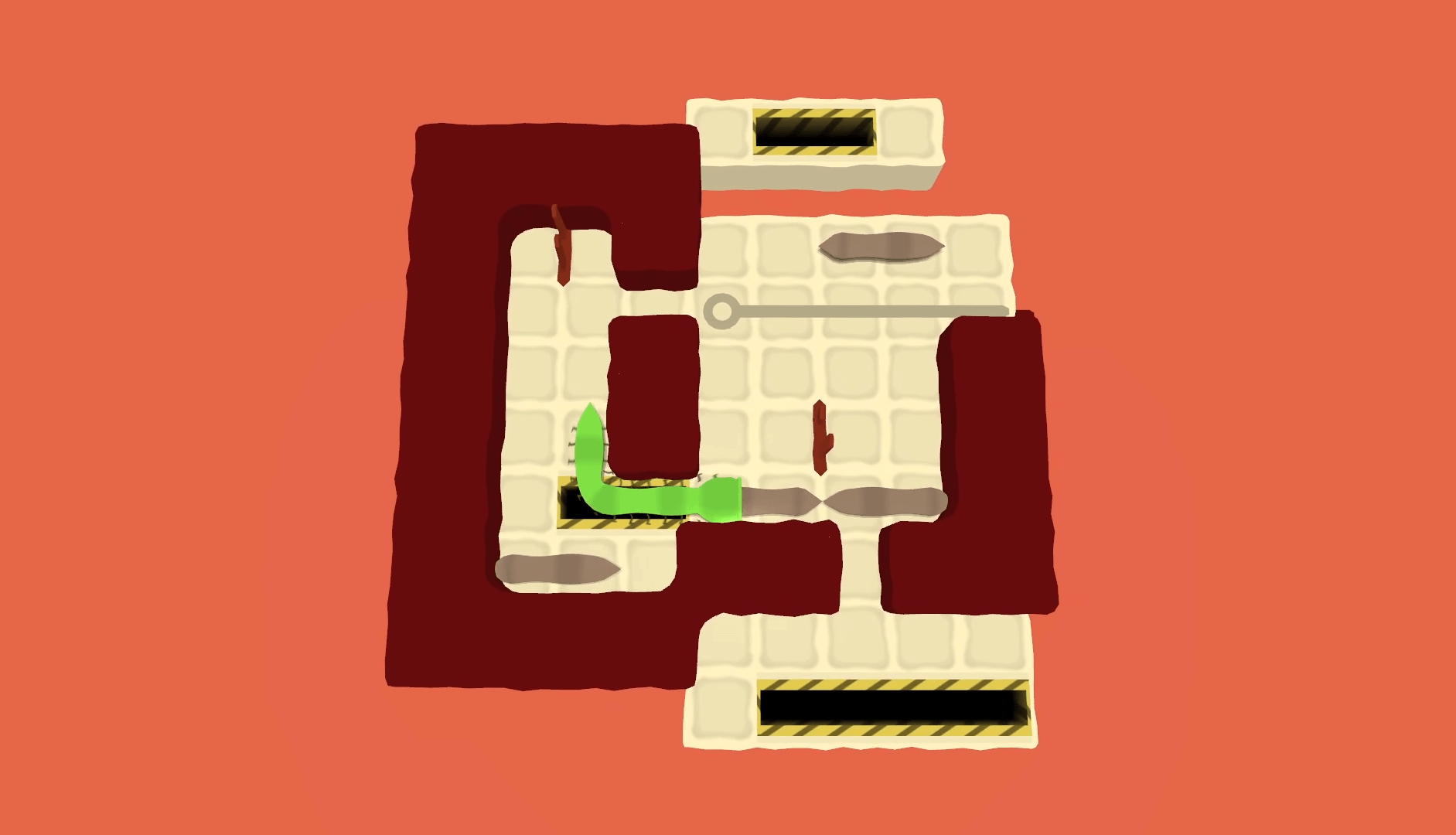What do you get when you combine classic Sokoban puzzles with mind-bending worm movements? You get Can of Wormholes, a brand new and fascinating puzzle game by solo developer munted finger games! I begin the game as a sentient tin can containing an endless supply of (worm)holes, brought together by a robotic hand mixing up some chemicals and setting its creation loose.
There, the game introduces me to the main mechanics — rolling my can to move around and push objects, before launching circular wormholes to solve little self-contained puzzles with my snake-like worms to accumulate energy. (If this description sounds bizarre, that’s because it is. Bizarre and brilliantly designed.)
Can of Wormholes consists of several worlds accessible by an elevator of sorts, and there is a large control room I can access after beating the first world “Blue” — where the energy I’ve collected becomes directional controls for several worms on a digital screen interface. It’s worm-ception, and one of the coolest meta-mechanics Can of Wormholes has to offer.
There must be something more to solve here: the worms on the screen are heading towards a common goal.
Without giving away too much, the game’s puzzle design introduces mechanics that are simple to learn, but difficult to master and they lead to deep interactions. In Matt’s news piece he highlighted the very unique hint system present within Can of Wormholes: Each hint is a mini-puzzle that directs your attention to an idea that’s key to solving the larger level. The ingenuity on display truly shines as a lesson on how puzzle game developers can make hint systems a more integrated part of the gaming experience.
As the puzzles got progressively more difficult, I was soon making use of the hint system on pretty much every level. Yet using hints in Can of Wormholes doesn’t take away the satisfaction of solving each puzzle, unlike taking hints in many other games, which can often feel like “giving up.”
The game never felt stale to me, and the constantly growing roster of mechanics kept me glued to my screen for hours on end. When I think I’ve seen it all, Can of Wormholes finds a way to subvert my expectations and prove to me that there’s so many more ways this can go.
I quickly grew attached to my sentient little can of worms, and when I’d finally collected enough energy, I felt myself smiling wide at the game’s ending and applauding the creativity found within this mind-bending, wormhole-creating, and strangely adorable puzzle game.
We spoke to Ben, the solo developer behind munted finger games, to get more insight into the development of Can of Wormholes:
How did the idea for Can of Wormholes come to you?
“The game grew organically over time from a pile of prototypes I was experimenting with. The first time I knew I had something interesting was when I was experimenting with the backwards movement of a snake-like creature.”
“Simply navigating the creature around a confined area felt like an interesting challenge in itself. Having a long flexible player character means that your body is not just your avatar in the world, but it is also both an obstacle and a tool that can be used in puzzle solving.”
“When I started experimenting with cutting up the creatures (In game!! Don’t call the authorities!) it became apparent that the objects that you push around in the world could be the very same creatures as the player character. This was the moment I knew I had to make a complete game out of the idea.”
The title is clearly a reference to wormhole theory and the phrase “can of worms”, what else inspired the design of the game?
The obvious one would be Snake! I lost a lot of hours playing this on my Nokia 1110. Stephen’s Sausage Roll would be the second inspiration. This was the game that made me realize that the objects that you manipulate within a Sokoban-style game world can themselves have interesting and subtle interactions just begging to be teased out of them.
The title of the game came surprisingly late, but it just felt so right. At first I didn’t know what the overworld character was going to be, but once worms and wormholes started popping up everywhere in the design, the name just popped into my head. I decided to double down on it and make the player character into a literal tin can filled with worm holes. Once I implemented the creepy worm legs carrying the tin can, I couldn’t go back.
You mentioned loving hand-crafted puzzles, what were some of the earliest or most memorable that you’ve played?
“Despite being a lifelong gamer, I never played many puzzle games growing up. I adored games like The Secret of Monkey Island and Lemmings but most of the time I’d be playing action games.”
“My love for hand-crafted puzzles instead came from the pen and paper world. I loved solving Sudoku, but I noticed there was a huge gap in quality between the computer-generated ones and those that were hand-crafted by a person. Sure, at a glance they’re both just numbers in a grid — but a good designer can craft the puzzle in a way that leads you down a specific path of discovery. They can teach you certain logical tricks and then you can reuse them again in interesting ways within the same puzzle.”
“They succeed in keeping the solution path interesting from beginning to end, which is something most computer-generated puzzles fail to do. Once Cracking the Cryptic introduced me to the world of variant Sudoku, I never looked back!”
“Thankfully, this same design philosophy can be found in many modern puzzle video games. Games such as Stephen’s Sausage Roll, A Monster’s Expedition, Bonfire Peaks, and Baba Is You excel at this. There was something so intriguing about a game that had so little variation in the objects in the world, yet they could interact in seemingly limitless ways. The perfect puzzle to me is one which gives you almost nothing to work with and feels impossible to solve until you get that perfect lightning strike in your brain of ‘…whoa, what if?'”
Can you walk us through a typical day of working on Can of Wormholes?
“I have zero structure. Some days I’d roll out of bed and jump straight on the computer, forgetting to eat breakfast or take a shower until way too many hours have passed. I would easily clock up 16 hours of game work on those days. Other days I’d be staring at the screen with a blank brain trying to fight the urge to lose another couple of hours to YouTube.”
“Oddly enough, I think the most productive moments during development were when I’d take a break from the computer and walk to the grocery store to do my shopping. While walking, I’d be listening to music and just thinking about the game.”
“What if a worm chopped off its tail while consuming another worm? What implications would that have? Most of the interactions and puzzles in the game were designed in my head during these walks. I don’t know how I managed to avoid walking directly into a wall then.”
What’s it like being a one-man show, and how did you feel when you pressed “launch” on Steam?
“A big positive of being a one-man show is that I get to wear many hats. When I tire of writing code, I can work on designing more puzzles. If I tire of creating puzzles, I can pick up the guitar and create some music for the game. It really helps keep the day-to-day work from becoming stale.”
“Thankfully, I do have a non-game related programming job which helps keep me sane and social. I’m not sure it would be healthy for me to do the solo developer thing full time!”
“Clicking the launch button was completely terrifying — I had no idea what to expect. I tried not to have expectations of how it would be received. I spent so long working on something in isolation and the idea of letting it loose into the world was nauseating, but exciting. I’m so thankful and relieved that reviews are very positive and that everyone seems to be enjoying it!”
How deep does the wormhole go?
“We’ve yet to find out! That’s the very question I kept asking myself while making the game. Despite the very few different elements in the game, they feel like they have many interesting interactions for us to discover. Custom levels will be supported shortly and I will be exploring interactions beyond those possible within the base game. Stay tuned!”
Thank you, Ben, for taking some time to chat with us. Can of Wormholes is available now on Steam. This interview has been edited for length and clarity.







Leave a comment